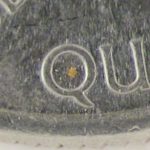Phylloxera in Colorado Grapes-2016
What is Phylloxera?

A single phylloxera inside the Q on a quarter.
Grape phylloxera (Daktulosphaira vitifoliae) is an insect that is related to aphids. There are two forms of this pest, a more serious and damaging form that feeds on roots of grape plants and a less serious form that feeds on leaves that causes leaf galls to develop.
The insect migrates between leaves and roots; with winged and wingless forms developing at each stage of migration. A full life cycle of the insect with both leaf and root feeding forms may or may not develop, depending on the strain of phylloxera present and the variety of grape infested.
Has Phylloxera been detected in Colorado?
In August 2015 foliar forms of phylloxera were detected for the first time in Colorado in a Larimer County vineyard. Leaf galling symptoms were present but no other visual signs of infestation were detected. Sources of this infestation were thought to have originated from vines sourced from an East Coast nursery.
In November of 2016 root galling forms of phylloxera were detected in a vineyard in Mesa County. Plants were symptomatic showing symptoms of stunting, leaf chlorosis and root galls. Source of this infestation is thought to have originated from a West Coast nursery.
How does it move?
The main mechanism of phylloxera spread over long distances is on grape nursery stock. Phylloxera is known to occur in grape producing states in the Eastern U.S. and California. Whenever purchasing grape vines thoroughly inspect vine roots prior to planting.
Potential impact on the Colorado wine industry
Phylloxera infestations on roots will damage the plant by disrupting water and nutrient flow between the root and upper plant parts. Initially the plants infested with phylloxera appear weakened, stunted, with leaves lighter in color that may look like they are suffering from a nutrient deficiency.
Rootstocks with Vitis vinifera parentage are more susceptible. Resistant rootstocks are available and use of resistant varieties are the most effective means of control. Unfortunately a large amount of plants utilized in the vineyards located on Colorado’s Western Slope are ‘own rooted’ vines of Vitis vinifera varieties (not grafted) and therefore more susceptible to phylloxera infestations. It should be noted that ‘resistant’ rootstocks and varieties are not truly resistant, but rather tolerant to phylloxera. Roots of ‘resistant’ rootstocks and varieties may still be infested by phylloxera, but vine vigor and productivity is not negatively affected.
The majority of grapes grown commercially in Colorado are grown on their own roots because a vine will recover better and be more tolerant of cold. But Colorado vineyards are unusual compared to other regions of the United States. Vineyards in other regions have had to switch over to using grafted rootstocks to tolerate significant phylloxera infestations.
Why has there been no regulation in the past?
The Colorado Agriculture Pest Survey Program (CAPS) has been monitoring and surveying grapes in Colorado for several years. This program is funded by the Farm Bill and is a cooperative effort between Colorado Department of Agriculture and Colorado State University. The phylloxera infestation on the Front Range was discovered during CAPS surveys. The infestation in the Western Slope vineyard was discovered in response to the grower requesting help from CSU’s Viticulture program. It appears that both infestations were detected early, and all precautions have been taken to eradicate the known symptomatic plants.
Regulatory programs to prevent the introduction of phylloxera were not thought to be necessary because the pest can be prevented with the use of grower best management practices. These include purchasing vines from nurseries in areas free of phylloxera, growers making the effort to protect themselves by inspecting the roots of newly acquired vines, and use of vines grafted to resistant rootstocks.


